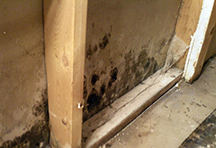As well as leading to adverse health effects, increased levels of mould growth in buildings can decrease the structural integrity of materials. Our trained personnel can identify areas affected by mould, and safely remove the mould and any contaminated material. Once the area is decontaminated, proper environmental conditions must be established to ensure the problem does not return.
What is mould ?
Mould is a living organism which reproduces by releasing spores into the air. These spores are carried around by currents of air and begin to grow when they land in a suitable environment.
What influences mould growth and how can we control it ?
Mould requires moisture and a food source to grow. Food sources are often cellulose based building materials, cloth or even dust. Food sources can be controlled by eliminating unnecessary high risk items, for example using plastic totes instead of cardboard boxes in high humidity areas. Moisture can be controlled by such means as dehumidification, insulating water pipes, avoiding hanging clothes to dry inside and the use of fume hood fans when cooking or bathroom exhaust fans when showering. Stagnant air can also be a factor in mould growth (ridge/soffit/gable vents are used to circulate air within an attic space or simply pulling furniture slightly out from walls). In general, mould prefers dark places as opposed to sunlit areas.
What are the risks ?
People have different sensitivities to mould and will therefore react differently to mould exposure. Characteristics are often respiratory problems and asthmatic-like in nature. Common symptons are coughing, congestion, shortness of breathe or wheezing as well as irritations such as rashes, sore throat, headache, itchy eyes and runny nose. For asthmatics, asthmatic episodes can be brought on by breathing mould.
